Issue #38 | 3sixteen’s Andrew Chen Is on a Good Run
On building a lasting brand, personal style, tattoos, running, and more
Hello again,
The other day I was talking with a friend about the difference between Made in the U.S.A. Levi’s and current day Levi’s, and how the quality of the denim of today’s jeans vs. jeans from the ‘90s and earlier just doesn’t compare. He asked if there were any brands based in New York still making jeans in the U.S. Only one came to mind: 3sixteen.
Founded in 2003, originally with a small line of graphic Ts, 3sixteen is at its heart a denim brand. In 2008, 3sixteen released its first pair of jeans, the SL-100x, made from a custom designed fabric from Kuroki Mills in Okayama, Japan. Everything about the jeans then and now was chosen with an eye for quality and versatility. Today, 3sixteen has several fits of jean with more than 10 fabrics, all cut and sewn at a factory in San Francisco. The brand has also built a curated line of basics, shirt, jackets, footwear, and accessories, all crafted with the same mentality as the jeans.
I’ve always admired 3sixteen, so a few weeks ago I reached out to the brand’s 44-year-old co-founder Andrew Chen. We met for coffee outside Elizabeth Street Garden to discuss the brand’s evolution, his personal style, tattoos, passion for running, and more. The interview has been edited for length and clarity.
FRONT OF BOOK: I was reading some interviews with you earlier today and I was surprised to find out that 3sixteen was 20 years old.
: Last year was 20, so this is 21 now.
Oh, wow. So can you go back to the beginning and how this all started for you?
Yeah, so that was 2003. I started a graphic T-shirt line with a friend of mine, and it was just meant to be some kind of creative outlet. I was working full-time in my job for a couple of years at that point. I was in IT consulting. When you’re in consulting, you’re always working on these projects that may or may not get implemented and there’s no physical output. And over time, that got frustrating, because they would pay hundreds of thousands of dollars to these consultants to come in and propose what to do and how to do it. And then at the end they’d be like, ‘Ah, we’re going to go in a different direction.’ Obviously you still get paid to do the work, but there was nothing real or tangible that was coming out of it. I wanted to start making graphic T-shirts that were similar to the ones that I was really into at the time. Streetwear was just kind of like a burgeoning industry. It meant something totally different than what it means now…
We designed our first pair of jeans that released in 2008, and they were raw indigo selvedge. They were made in the USA and retailed for $175. When you’ve got jeans that are made overseas for $90, $98, it doesn’t make sense for most of the stores that we were already working for. So that was pivot number one. We had to find a new customer base for what we did, and that’s where jeans really took off for us.
Johan (Lam, 3sixteen’s other co-founder) had been friends with the founder of Self Edge, Kiya Babzani, for many years. (Ed. note: Andrew is now a co-owner of Self Edge.) We’d worked together on a couple other things outside of Self Edge, and when we decided to launch these jeans, we were like, ‘Would you like to carry them? They’re selvedge. They’re made in the U.S.’ And he was like, ‘I don’t know that it really fits. Everything else I’m bringing in is super exclusive brands from Japan might not really fit what’s going on with Self Edge.’ We’re like, cool. We sold our first run the next year. Then he said, ‘I think that there’s room for an entry level brand at Self Edge, and I think that it could be you guys.’ So he picked it up that same year we partnered with him to open up Self Edge New York.
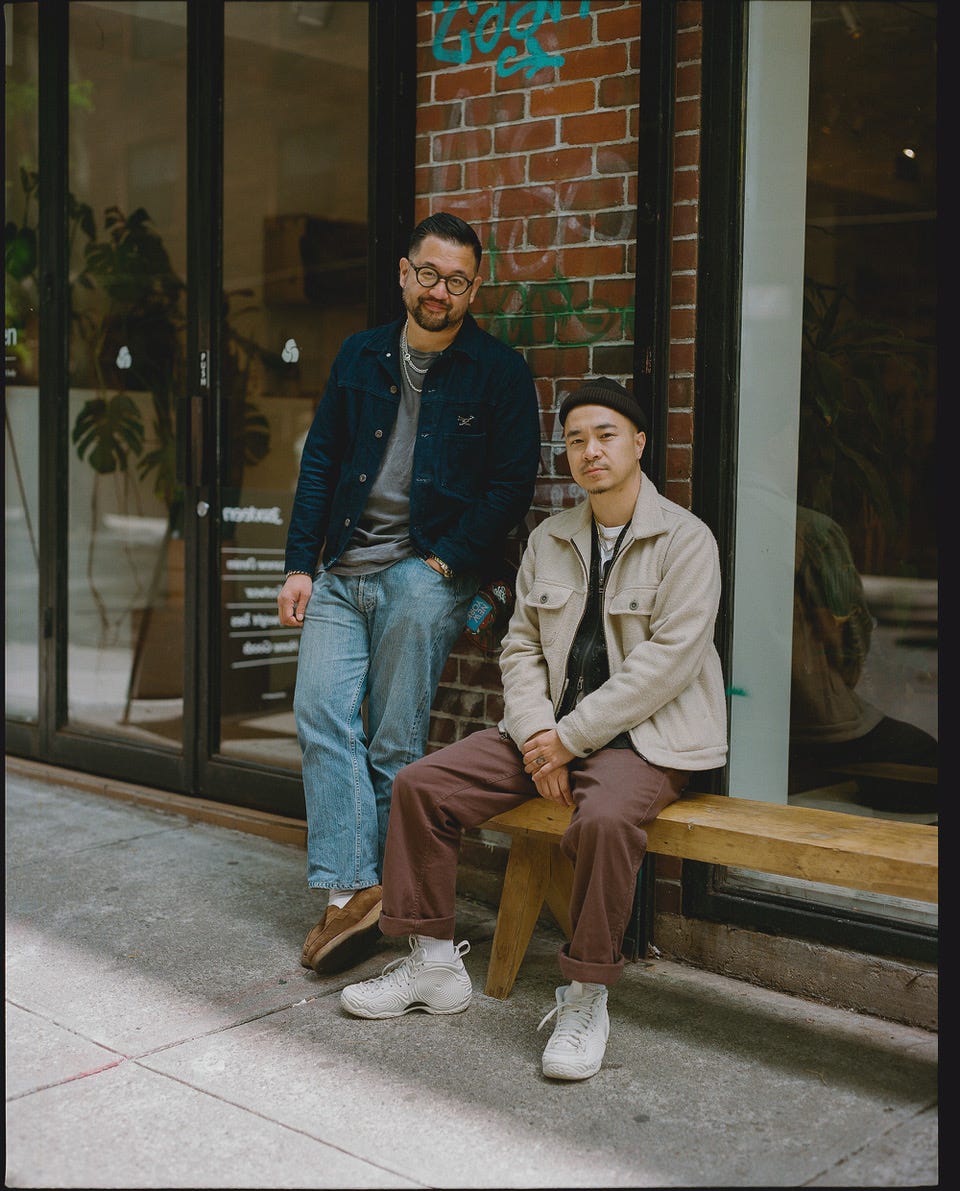
Where did the name 3sixteen come from?
John 3:16. I’m a Christian, Johan’s a Christian, and I think at the time that we started the brand, we wanted to just operate a business according to those principles without having anything else—we didn't want it to be transactional. It was just like, we want the brand to be fully representative of who we are and the kind of decisions that we make to run it.
What did you study in college?
Economics and public policy major. And Johan was a communications major at University of Southern California.
So how did you guys learn the fundamentals of making things like T-shirts and jeans?
T-shirts are easier because when you start—and a lot of people still get their start now—you design a graphic, you still have to learn how to do that, but you’re not in charge of producing the garment itself. You’re buying T-shirt blanks and you’re printing on them. Now we make our own T-shirts. But back then you’d buy some T-shirts and put it on. And so at that time, the exercise was in building the brand and building something that people were into and believed in and wanted to follow along with. And then as we went, and as the aspirations grew, we were like, we want to make more than t-shirts. We want to make jackets, we want to make sweatshirts…
When we made jeans, we started off with a production manager who we told, ‘Hey, these are the fits that we want to do, and these are the fabrics.’ But over time, as Johan was out there and meeting with factories, he found our pattern maker in San Francisco. He found our current factory that we’ve been working with for over a decade in San Francisco. Every time you go and you visit and you talk to the sewers, you talk to the factory owners, and you have experience with not one or 10, but hundreds of production runs, you just pick it up as you go. Wesley, our lead designer for our collection, didn’t go to fashion school either. He just loved it. He grew up taking garments apart and putting them back together and trying to figure out how it worked. And of all of us right now, I think Romeo, our technical designer who’s been with us for a year, he’s the only one that’s in fashion school right now.
Oh, really?
He’s taking pattern making and he’s learning, and so he’s able to bring knowledge in from there. But all of this was self-taught and making mistakes and figuring it out and leaning on the shared wisdom of people who have been doing this for a really long time, and then being open to teaching us.
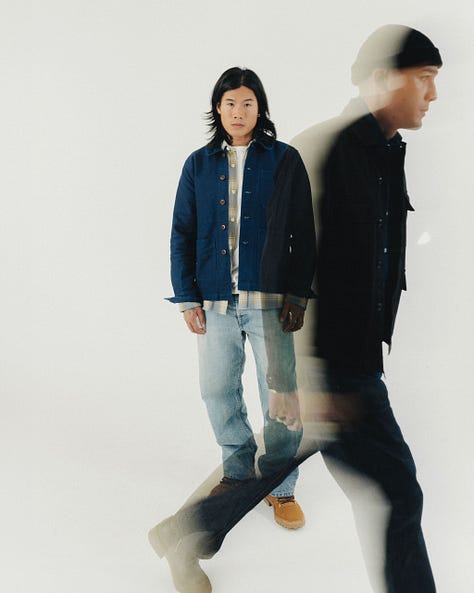
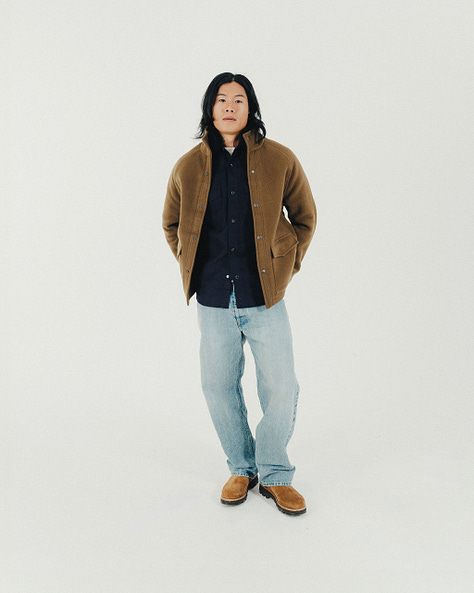

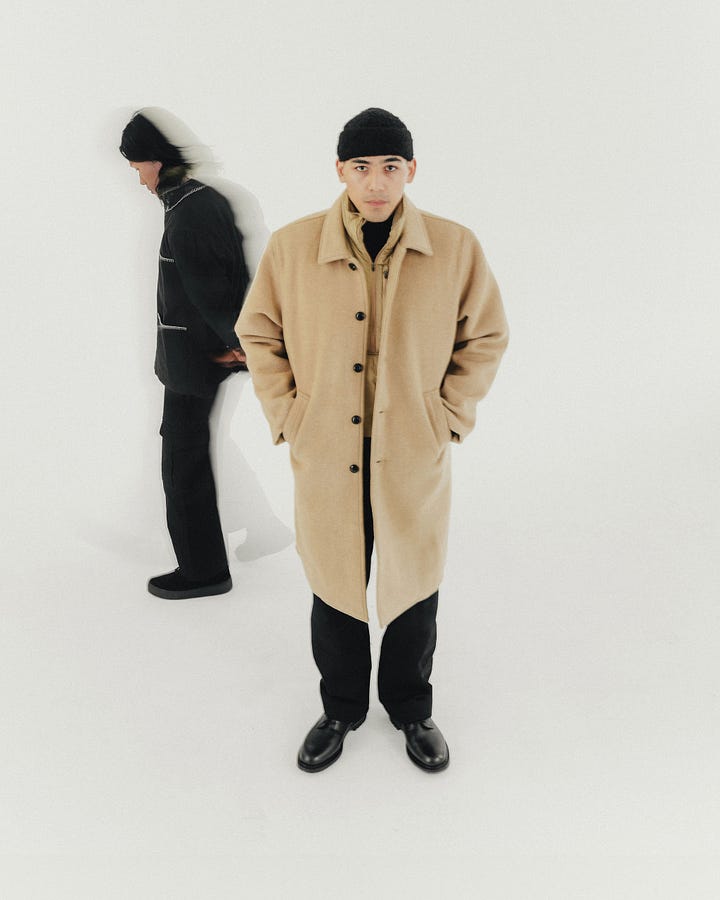
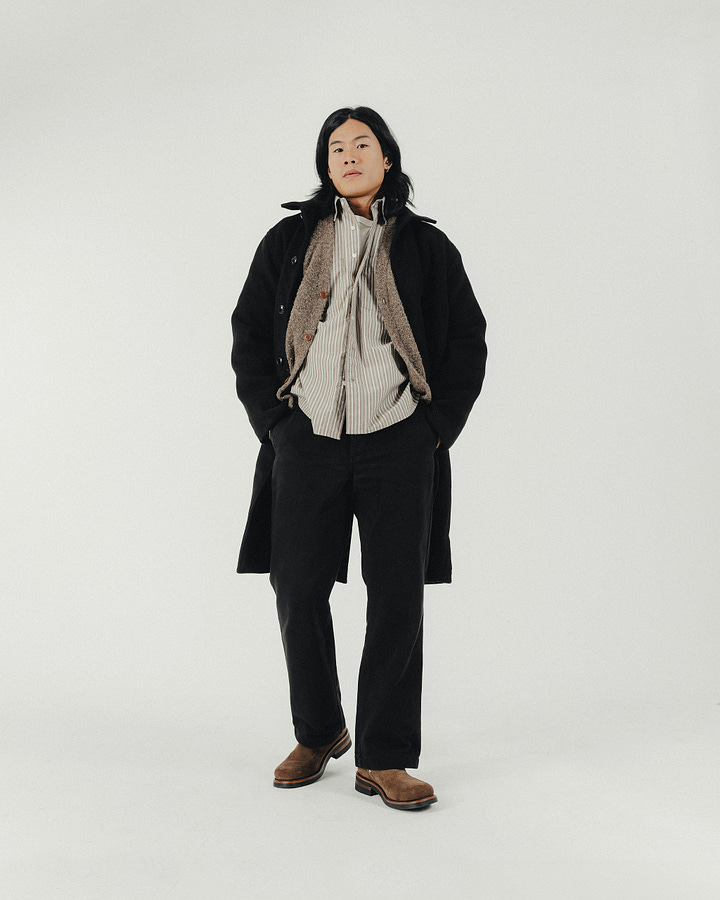
When you look back on the last 10, 15 years, how would you say the brand’s evolved?
It’s really the journey from trying to keep up with denim demand, because there were three or four years where we needed to make more jeans, but we couldn’t afford to. So the trajectory of the business was, order as much fabric as you can afford, bring it into the States, make as many jeans as you can afford, and by the time you’re shipping them out to stores, they’ve sold through everything and they need more two weeks after it’s landed. But you can only afford to make whatever you can after they’ve paid you back for it…
We took some risks on our own. Obviously we borrowed against ourselves personally to try and speed the process up. There was one crazy time where Johan’s girlfriend, now wife, but at the time, I want to clarify, only girlfriend, she let us borrow law school loans that were not due until the end of the semester, because we needed money so badly. Cashflow is what was killing us. And so yeah, she was like, ‘I just need it back in my account by May.’ And we took that money and we used it to buy fabric, and we told her, ‘We promise we’ll get it back to you.’ And we did it. Other times it would be like, ‘Who's got $5,000 right now?’
And we would just believe in the fact that it would come back. And so again, looking at the 10 to 15 years, that was the journey from bare subsistence, flipping the money, that’s all it was. We were flipping money to grow, trying to meet demand, to being able to explore building a collection. Because I think for many, many years, people looked at us as a denim brand. And if you were to ask me today to this day what the brand is known for, I would still say that it’s known for denim. But we had a strong desire to be able to build a seasonal collection around it….
How much of the lines reflect your own personal style? Are you thinking about things that you want to wear and do wear?
Oh yeah. That still holds true for everything that we make—obviously, none of us own everything that we make, you don’t need that many clothes. But everything in the collection moves us and excites us. And we’re not at the size where you’ve got a merchandiser coming in and saying, ‘Hey, you’re losing a lot of money if you don’t make these 50 styles. So just make them.’ I guess if you’ve got a board of directors or investors and you’ve got to hit these financial goals all the time, that’s when you start having to grow for the sake of growth. And we don’t have to do that. We’re excited about every single seasonal piece of the collection. And you can do that when the line is small.
What do you have in the fall collection that you're excited about?
Lot of things. We launched a new jean fit last year called the the Relaxed Straight. It’s our widest cut that we make. It’s not baggy by any means, but it’s a pretty relaxed leg all the way through with a little bit of taper. And over the past few years, five years, we’ve been starting to get into washes. We were kind of purist about it for a while because in our opinion, nothing looks as good as a worn in pair of raw denim jeans. Raw denim fades a certain way. This has to be done through a wash process. And so we realized that we were missing out on a lot of customers that just wanted a jean with that sort of look. We have what we call a vintage wash. It’s like a very, very light blue… We have some really nice wool Mac coats, like a wool cashmere Mac coat. It’s got a lot of motion to it. It’s drapey, a coat that moves with you when you walk around. It flows. It’s part of the reason why I love living in New York, is you get legitimate seasons.
I was wondering about your tattoos. When you got into tattoos, and how did you decide to go with the traditional thick line? I really love traditional tattoos, but I'm afraid to personally, you know what I mean?
I think that people who’ve waited a while to start getting tattooed usually will end up with better tattoos.
Oh, really?
Yeah, I think so. I mean, a lot of people get into it when they’re young and your taste might change, or you just start quickly. But if you’ve taken time to really look at what’s out there and figure out what excites you and what you’re into, I think that in many cases, people end up with get better ones, especially if you start getting tattooed later in life. I started getting tattooed in mid- to late-twenties. That’s pretty late. And all of this was built through relationships at Self Edge. There used to be a legendary tattoo shop across from us called Invisible. Invisible NYC, and the best Japanese tattooers in the city were all tattooing there
But I didn’t go to them to get a full Japanese sleeve. I just kind of did it piecemeal and became friends with them and them coming into the shop and me getting to know them. So almost everybody that I’ve gotten tattooed from I have a personal relationship with, which is really cool. If you’re sitting with someone and they’re carving you up for a few hours, it’s nice to know them and have conversation with them. So yeah, I actually have a couple of different styles of tattoo, but I think what pulls it together is that they’re all black and gray. Traditional American… I kind of collected them as I went. At this point, you just kind of pick a spot. Over time too, once you’ve gotten enough of them, then you get to start having fun ones.
I have a traditional one on my arm, and then some others, all hidden. But sometimes, I’m like, sometimes I just want to fucking go for it.
Got to start somewhere. You got to start creeping down the short sleeve line.
Exactly.
We have amazing, amazing traditional artists here.
Who do you recommend?
There’s R&D Tattooing out in Glendale that is a real, real old school shop with young people there that are working and old guys too. People who’ve seen tattooing from its early days to, because it was a biker, it was a bike gang shop when it opened up.
Oh, really?
That is a real old New York shop. I would say the experience of being there is super special. Lots of great artists there. A lot of the guys at 3sixteen love getting tattooed at Allied Tattoo. I really like their specific artists, but there’s a ton that are doing great work there. I don't like getting stuff from people that you have to wait a year to get something from.
I also resent the whole idea of having to apply to get tattooed. Like, isn’t this about something that I’m going to have on my body for the rest of my life?
Totally. And again, there’s plenty of great artists, and I think social media has made it so much easier than the intimidation of walking into a shop and asking and flipping through a book or picking something off a wall. Everybody’s portfolio is online now, so you’re able to kind of flip through and see is there something about this person’s work that I really like? And then you could just go from there, hit ‘em up, like email, call. If they don’t dm, if they don’t respond to any of those, keep it moving.
So you’re big into running, hey?
Over the past two and a half years, yeah. It’s become a very important part of my life for health reasons, for social reasons. I got into it because my gym closed down for a couple months and I was just looking for something that helped me stay active. But it was at a time when a lot of other people were doing the same thing…
I run with the same group of people every Wednesday night. In Queens. It’s been good for my creative process. I would say most times that I run, I try not to even have headphones on. Sometimes it’s just to clear the head, sometimes solve the problem, and it’s really good for me in that regard. And we’ve been able to rope it into the brand in small ways too. We’ve been designing a small active collection capsule.
Oh, cool.
It might sound strange for a brand that specializes in denim and clothing to make stuff with a stretch or moisture wicking. But we tried to approach it with the same design perspective that we’ve done other things, which is make sure that it’s versatile, wearable.
What do you normally wear of running?
I mean, before we started making our stuff, I started out with big brand things. It was more affordable, and I was trying to figure out what I liked. So I bought some Nike stuff, it worked well, but they didn’t have anything that was good for colder weather. Then I found Tracksmith, and they make really beautiful track merino long sleeves that I cannot say enough good things about. When it’s super cold out, it holds your body temps. Their stuff is really great. And then I found Satisfy, it’s very expensive, but everything functions exactly as it should. It’s very well thought out. The materials are beautiful. I don’t mind spending more on running stuff because I spend more on regular clothes than the average person does as well. Feeling good in the stuff that you put on is such a big part of wanting to go out.
For sure.
And now we make our own stuff. We have some running shorts, we have T-shirts, hats. But again, all that stuff is designed with the perspective of if you want to throw it on with a pair of jeans, it doesn’t look out of place. Whereas if you’ve got half-tights on, you can only run in, you can’t be walking around all day long in them. So that’s kind of the guiding principle for what we will make.
Thanks, Andrew, for the conversation and coffee. The FW24 line looks great.
And thanks for reading, everyone. I’ll be back next week with a dispatch from my recent trip to Paris. Have a great weekend and see you soon.
Mitch
Follow on Instagram
Question? Comment? Suggestion? Caught a typo? Email me at mitch.moxley@gmail.com








